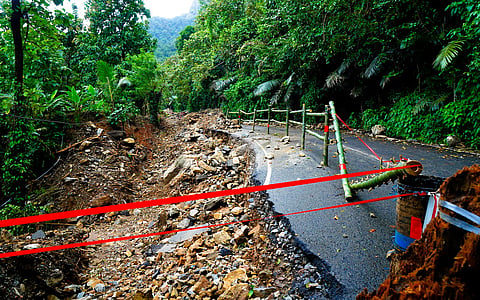

Kerala is on the verge of launching a groundbreaking disaster management plan, a model that can set a new standard nationwide. This innovative plan is uniquely designed to safeguard the state’s tribal community, particularly those residing in hazardous hilly terrains, from the annual onslaught of extreme weather events.
By integrating traditional indigenous knowledge for managing climate adversities with modern scientific rescue and rehabilitation methods, the plan aims to benefit approximately 484,839 tribal people living in over 6,000 hamlets, most of which are located in some of the highly fragile regions of the Western Ghats.
As the southwest monsoon approaches, the state has successfully piloted the community-owned disaster management plans in two of the most vulnerable and remote tribal hamlets located within the ecologically sensitive Western Ghats this past week.
The project, which focuses on enhancing safety and building disaster-resilient tribal communities, is currently operational in the highly vulnerable and remote areas of Swamiyaralakudy in Idukki district and Kurumbanmoozhi in Pathanamthitta district. In the coming months, it will be expanded to include other tribal hamlets throughout the state.
Both settlements are frequently affected by landslides, heavy rainfall, flash floods, and wildlife attacks, and they often risk being isolated during disasters.
Additionally, these hamlets struggle with limited road connectivity and fragile housing, which are significant challenges they must overcome.
The project, titled ‘Tribal Hamlet Disaster Management Plan’ (THDMP), is specifically designed for each identified tribal hamlet, utilising an efficient and locality-specific approach.
The Kerala State Disaster Management Authority (KSDMA) is actively partnering with the state’s tribal development department to expedite the implementation of this project, showcasing a united front in this vital undertaking.
Kerala is home to over 30 tribal communities, including several Particularly Vulnerable Tribal Groups (PVTGs).
“A substantial segment of indigenous people inhabit the state’s geographically isolated regions of the Western Ghats. Reaching out to them for rescue operations during emergencies remains a Herculean task. Most of the hamlets are located in areas prone to landslides and floods. Along with their social and financial disadvantages, the disaster vulnerability of these locations also makes the tribal traditional knowledge of recovery ineffective. In this context, we aim to empower them with both traditional and modern knowledge and techniques to help them overcome the challenges posed by extreme weather events,” O R Kelu, Kerala’s Minister of Welfare of Scheduled Castes, Scheduled Tribes, and Backwards Classes, told Down to Earth (DTE).
“Empowering tribal communities with customised solutions ensures no group is overlooked in Kerala’s disaster preparedness efforts,” said Sekhar Lukose Kuriakose, member secretary of KSDMA.
“Once operational, the project has the potential to establish a benchmark for community-based disaster management, focusing on adaptive methods and collaboration to shield the most vulnerable populations from future crises,” said E Anagha, a rural development specialist associated with the project.
According to her, KSDMA’s evaluation shows that villages with significant tribal populations, particularly in Wayanad, have faced relocation and losses due to annual monsoons since 2018. Extreme rainfall events and other disasters have negatively impacted them.
The tribal villages are located in disaster-prone areas and are at risk from earthquakes, flooding, landslides, human-wildlife conflict, and forest fires. Many of these villages are in remote regions and face unique challenges due to a lack of support services. They must be aware of the assistance available through the KSDMA system and have effective evacuation plans.
Ground-level studies conducted by KSDMA have shown that tribal populations in the state have experienced significantly fewer casualties than other societal groups during calamities. Such evidence is a testament to the resilience and effectiveness of the project’s approach.
“Due to their indigenous knowledge, the tribal communities in the region remained completely unscathed during the Wayanad landslides,” said Anagha.
“It is crucial to integrate traditional knowledge and practices with modern technological advancements to improve disaster preparedness, ensuring that disaster management plans are developed without compromising their beliefs and traditions,” she said.
The project template, developed by KSDMA, is designed to foster sustainable disaster resilience through culturally appropriate strategies. It underscores the importance of leveraging indigenous knowledge for risk reduction, preparedness, and recovery. The initiative calls for enhanced collaboration among government agencies, non-profits, and tribal stakeholders, inviting everyone to contribute to the empowerment of these communities through capacity building and participatory planning.
According to project officer Midhila Mallika, the project follows a systematic approach called ‘Disseminating Indigenous Knowledge for Disaster Resilience’. This approach focuses on sharing, preserving, and promoting traditional practices, recognising the value of time-tested ecological understanding and adaptive strategies rooted in tribal cultures.
The methodology is structured across five phases:
Mitigation: Reducing risks through landscape-specific measures.
Preparedness: Community training and resource mobilisation.
Response: Swift, coordinated action during disasters.
Recovery: Rehabilitation and infrastructure restoration.
Prevention: Long-term strategies to avert future crises.
A state-level methodology finalisation workshop established the groundwork for the THDMP, followed by a subsequent workshop to align stakeholders on implementation protocols. The initial preparation of the Disaster Management Plan began in Wayanad district, where post-impact assessments indicated a need for a revised methodology. Challenges such as geographic isolation, cultural diversity, and varying access to resources required a more adaptable framework.
The final plan emphasises the project’s integration with government systems, such as the Gram Panchayat Development Plan for rural development. The plan includes capacity-building workshops for tribal leaders and local administrators and technology integration that involves hazard mapping and early warning systems.